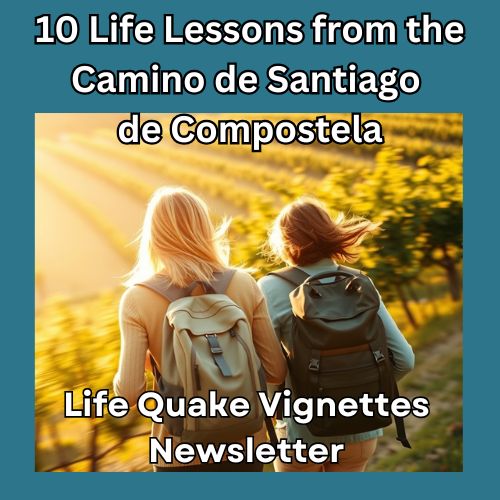In Short
Ever heard, “I am not your therapist” on a retreat? Not all retreat hosts are therapists. They can be, with all the qualifications needed behind their names, but many are not. I do have the qualifications, but therapy is not part of any of my retreats. Coaching, on request, yes, and at additional cost, and ongoing mentoring after the retreat, but during the retreat, no therapy.
Unless it explicitly says so in the description, do not assume that a retreat is a healing retreat.
Think of retreat hosts like me as skilled gardeners who prepare the soil, plant the seeds, and provide the right conditions—but you’re the one who has to nurture the plants so that they grow strong and healthy.
The Sacred Art of Holding Space Without Healing Souls
Picture this: You’ve just paid good money to escape your regular life, expecting someone to wave a metaphorical magic wand and solve all your problems over artisanal breakfast and sunrise yoga.
Plot twist—that’s not how transformation works, and any retreat host worth their Himalayan sea salt knows it full well.
The retreat industry has a dirty little secret that nobody talks about at wellness conferences: the line between facilitation and therapy isn’t just blurred—it’s been trampled by well-meaning hosts who’ve forgotten their role and participants who’ve outsourced their healing journey into someone else’s hands.
Luna’s “I am not your therapist” Wake-Up Call
Luna Ashton had been running wilderness retreats for seven years when Sarah arrived at her mountain sanctuary in the French Pyrenees, dragging what felt like the weight of the world behind her in her backpack.
The morning mist still clung to the valley as Luna watched Sarah unload her emotional baggage along with her rucksack. The acrid smell of anxiety seemed to follow Sarah everywhere—that sharp, metallic scent that accompanies someone who’s been holding their breath for months. During the welcome circle, Sarah’s voice cracked like autumn leaves underfoot as she shared her recent divorce, job loss, and her mother’s terminal diagnosis.
“I need you to fix me,” Sarah whispered, her words barely audible above the pine trees swaying in the mountain breeze. “I’ve tried everything else.”
Luna felt the familiar tug in her chest—that rescue reflex that had gotten her into trouble before. The stone circle where they sat had witnessed countless moments like this, its ancient presence both grounding and challenging. She could taste the expectation in the air, thick and sweet like overripe fruit.
“Sarah,” Luna said, her voice steady as mountain stone, “I can’t fix you. I am not your therapist. But I can create a space where you can work out how to fix yourself.”
Sarah’s face crumpled, and Luna’s heart lurched. Every fibre of her being wanted to reach across the circle, to absorb Sarah’s pain like a sponge, to become the mother-therapist-saviour that Sarah desperately needed. The familiar weight of others’ expectations pressed against her ribs like a too-tight corset.
But Luna had learned this lesson the hard way.
Three years earlier, she’d tried to be everything to everyone on her retreats. She’d stayed up until 2 AM listening to participants’ life stories, given free therapy sessions disguised as “deep conversations,” and prescribed solutions like a spiritual vending machine. The lavender-scented journal she kept during that period was filled with her own burnout symptoms: exhaustion that felt like lead in her bones, resentment that tasted bitter as burnt coffee, and a growing emptiness that no amount of helping seemed to fill.
The breaking point came when Marcus, a participant from her previous retreat, called her at midnight three weeks after returning home. He was drunk, sobbing, and threatening self-harm because the “breakthrough” he’d experienced during her program hadn’t lasted. Luna found herself talking him through his crisis while her own family slept, wondering how she’d become responsible for someone else’s mental health without any training or legal protection.
That night, sitting on her kitchen floor with the phone finally silent, Luna realised she’d crossed a line she didn’t even know existed. The cold tile beneath her felt like a wake-up call—literally grounding her back to reality. She’d become a therapist without credentials, a saviour without boundaries, and a healer who was slowly destroying herself.
Now, facing Sarah’s expectant grief, Luna drew upon every ounce of that hard-won wisdom. The smell of wild thyme and mountain air filled her lungs as she breathed deeply, centring herself in her role—not as Sarah’s personal therapist, but as the guardian of a transformative space.
“Here’s what I can offer you,” Luna said, her words carrying the quiet authority of mountains themselves. “I can create a container strong enough to hold your pain without trying to eliminate it. I can facilitate experiences that might shift something inside you. I can witness your journey without taking responsibility for your destination. And I can hold space for your healing without pretending I’m the one doing the healing.”
Sarah’s eyes filled with tears—but this time, they looked different. Not the desperate tears of someone drowning, but the releasing tears of someone learning to swim.
Over the next five days, Luna watched Sarah transform—not because Luna fixed her, but because Luna refused to. In the silence of morning meditation, Sarah heard her own inner voice for the first time in months. During the challenging mountain hike, she discovered strength in her own legs, not in Luna’s encouragement. Around the evening fire, she found healing in sharing her story with fellow participants, not in Luna’s interpretations.
The breakthrough moment came on the final morning. Sarah approached Luna as the sun painted the mountains gold, her footsteps light on the dewy grass. The desperate edge was gone from her scent, replaced by something clean and open—like rain-washed air.
Five Key Takeaways
1. Boundaries Create Safety, Not Distance When retreat hosts maintain clear professional boundaries, they create a paradox: the safer the container, the deeper participants feel free to go. It’s like a climbing rope—the more you trust it won’t break, the more willing you are to take risks.
2. Projection Is Part of the Process Participants will inevitably project their needs for healing, parenting, or saving onto their retreat host. Recognising this as normal psychological phenomenon rather than a personal request helps hosts respond with compassion rather than codependency.
3. Facilitation vs. Therapy: Know Your Lane Retreat hosts facilitate experiences and hold space. Therapists diagnose, treat, and heal psychological conditions. Crossing lanes doesn’t just risk burnout—it risks harm to participants who need proper professional support.
4. The Power of Productive Disappointment When participants realise their retreat host won’t rescue them, initial disappointment often transforms into empowerment. This “productive disappointment” is where real growth begins—when we stop looking outside ourselves for salvation.
5. Witness, Don’t Fix The most transformative thing a retreat host can offer is pure witnessing—seeing participants’ struggles and growth without immediately jumping in to solve, interpret, or heal. This witnessing creates space for participants’ own wisdom to emerge.
The Retreat Boundaries Exercise
This powerful exercise helps both retreat hosts and participants understand the difference between support and rescue.
For Retreat Hosts:
- Examine Your Rescue Patterns: Write down three situations where you felt compelled to “save” a participant. What triggered this urge? What were you trying to heal in yourself?
- Map Your Professional Territory: Create two columns. In one, list everything that IS your responsibility as a host (creating safe space, facilitating activities, maintaining boundaries). In the other, list what ISN’T (participants’ emotional outcomes, their life choices, their healing journey).
- Practice the Sacred No: Write three scripts for redirecting therapy-seeking participants back to appropriate resources while maintaining compassion and connection.
For Retreat Participants:
- Identify Your Saviour Projections: Before your next retreat (or honestly assess your last one), write down what you hope the host will “fix” about you or your life.
- Reclaim Your Power: For each item above, rewrite it as something you can explore, heal, or discover for yourself during the retreat experience.
- Create Your Support Map: List three professional resources (therapist, coach, doctor) you can access for ongoing support beyond the retreat experience.
“The cave you fear to enter holds the treasure you seek.” – Joseph Campbell
When we try to pull people out of their metaphorical caves, we rob them of discovering their own treasures. Campbell understood that the hero’s journey requires the hero to do their own walking—no one else can take the transformative steps for them.
A retreat host who tries to extract participants from their challenges becomes an enabler, not an empowerer. The “cave” of discomfort, confusion, or emotional pain isn’t something to be avoided or immediately soothed—it’s the very place where growth happens. By maintaining boundaries and refusing to play saviour, retreat hosts honour the participant’s heroic capacity and ensure the treasure they find belongs truly to them.
Further Reading
1. “Hold Me Tight” by Dr. Sue Johnson While focused on relationships, Johnson’s exploration of attachment theory illuminates why people seek rescue from retreat hosts and how healthy boundaries actually create deeper connection. Essential reading for understanding the psychology behind projection.
2. “The Gifts of Imperfection” by Brené Brown Brown’s work on shame resilience explains why the helper’s high can become addictive for retreat hosts and why participants’ vulnerability shouldn’t become the host’s responsibility. Her insights on empathy vs. sympathy are game-changing.
3. “Boundaries” by Dr. Henry Cloud and Dr. John Townsend The gold standard for understanding healthy limits in helping relationships. Particularly valuable for retreat hosts who struggle with saying no or feel guilty for not fixing everyone who attends their programs.
4. “The Wounded Healer” by Henri Nouwen Nouwen’s exploration of how our own wounds inform our capacity to help others is crucial reading for anyone in the healing arts. He brilliantly articulates how to be present to suffering without taking it on.
5. “Trauma-Informed Mindfulness” by David Treleaven Every retreat host working with meditation, breathwork, or somatic practices needs this book. Treleaven explains how well-meaning facilitators can inadvertently re-traumatise participants and offers practical guidance for creating truly safe spaces.
Frequently Asked Questions
Q: What if a participant has a mental health crisis during my retreat? A: Have a clear crisis protocol that includes professional mental health contacts in your area. Your role is to ensure immediate safety and connect them with appropriate help, not to provide therapy yourself. This actually serves them better than trying to handle it alone.
Q: How do I show compassion without crossing therapeutic boundaries? A: Compassion is about witnessing and validating someone’s experience (“I can see this is really difficult for you”) rather than trying to change or fix it (“Let me help you process this trauma”). You can be deeply caring while maintaining clear roles.
Q: Isn’t it cold to refuse help when someone is clearly suffering? A: It’s actually the warmest thing you can do. Referring someone to proper professional help while maintaining your supportive role gives them both immediate appropriate care AND preserves the retreat container for their continued growth.
Q: What if participants complain that I’m not helping them enough? A: This often happens when people are used to outsourcing their healing. Hold firm to your boundaries while explaining your role: “My job is to create conditions for your breakthrough, not to create the breakthrough for you.” Most participants eventually appreciate this clarity.
Q: How do I handle my own urge to rescue participants? A: Recognise that your rescue urge often says more about your own needs than theirs. Consider getting supervision or therapy yourself to explore what drives this impulse. Remember: the best retreat hosts are those who’ve done their own work on codependency.
Conclusion: The Liberation of Limits
The most radical thing a retreat host can do in our fix-me culture is to refuse to fix anyone. This isn’t abandonment—it’s empowerment. When we stop trying to be everything to everyone, we become exactly what our participants need: a skilled guide who trusts their capacity for self-healing.
The retreat industry will be revolutionised not by hosts who promise more healing, but by those brave enough to promise less rescuing and more empowerment. In a world full of people trying to fix each other, the rare gift of someone who simply holds space for your own transformation is invaluable.
Your participants don’t need another therapist disguised as a retreat host. They need someone who believes so deeply in their inherent wholeness that they’re willing to let them discover it themselves.
Ready to experience the transformative power of held space without rescue? Join me for a Camino de Santiago walking retreat in the stunning countryside of southwest France, where ancient pilgrim paths create natural containers for self-discovery. These gentle walking retreats combine the meditative rhythm of footsteps with the healing power of community—all within clear, supportive boundaries that honour your journey as uniquely yours.
Learn more about upcoming Rediscover Your Natural Rhythm Camino walking retreats










10 Powerful Life Lessons Learned While Walking the Camino de Santiago – a free guide filled with 10 not just “quaint anecdotes” or Instagram-worthy moments (though there are plenty of those) but real transformations from real people who walked the same insight-giving trail you might want to walk one day – Subscribe to my monthly newsletter to Download the Guide

